Top News

March 20, 2019 Ryukyu Shimpo
Prior to starting construction on the Futenma Replacement Facility (FRF) in Henoko, Nago City, the Okinawa Defense Bureau (ODB) conducted a dugong survey and confirmed the presence of three dugong specimens.
Since construction in the ocean began the whereabouts of two of the specimens have become unclear, and as of February 2019 the only dugong whose whereabouts were confirmed was the specimen now found deceased.
Although the ODB denies that construction affects the dugong, it is clear through the ODB’s surveys that construction is affecting the condition of their habitat.
In August 2014 the ODB started setting up buoys and other equipment in the ocean, and conducting underwater boring surveys.
Since then, dugong feeding trails have stopped appearing in the seaweed beds around Cape Henoko. Dugong specimen C, who used to appear in the waters of nearby Kayo and was last spotted in June 2015, was reported after September 2018 to have moved to the waters around Kouri Island.
Specimen A used to appear frequently in Kayo, but his whereabouts have been unknown since September 2018.
There has been a decline in dugong feeding trails in the seagrass around Kayo since September 2018.
At most there were a total of 120 dugong feeding trails in Henoko, Kayo, and Abu within one month. However, in December 2018 and January 2019 feeding trails were not found in any of these spots.
Looking at the characteristics of the three dugong specimens as recorded by the ODB in its environmental impact assessments, the dugong specimen that was found dead had an indentation on the left side of its back that resembles the Japanese hiragana character “he.” This indicates that the dead dugong is the female specimen B, who is likely the mother of specimen C.
(English translation by T&CT and Erin Jones)
Go to Japanese
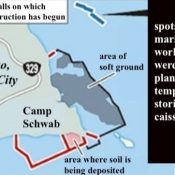
March 18, 2019 Ryukyu Shimpo
Recently it came to the Ryukyu Shimpo’s attention that due to an expanse of soft seafloor north of the land reclamation area, the Okinawa Defense Bureau (ODB) has abandoned its plan to establish three “marine work yards” there, for construction of the Futenma Replacement Facility (FRF) in Henoko.
The ODB had planned to temporarily place caissons (reinforced concrete boxes) for use in the seawalls at these marine work yards, but in 2017 it abandoned this plan.
It has not yet decided on a different place to temporarily set the caissons. Soft ground in Oura Bay not only requires ground reinforcement work, it is also likely to affect securing a spot to temporarily store caissons and lengthen the construction period.
The ODB plans to perform ground improvement work on the soft ground in the designated land reclamation area, but that does not include the soft ground in the marine work yards.
It has come to light that the ODB submitted a report to the National Diet containing documents that detail ground improvement work.
The ODB threw many stones to the bottom of the ocean to build pedestal-like structures in the marine work yards.
Thirty-eight cassions were to be built outside of Okinawa, hauled to Okinawa, and set atop the pedestals.
Because all of these caissons cannot be immediately placed in their permanent positions in the seawalls, a temporary storage place became necessary. It would be difficult to establish a work yard atop soft ground, because if even one 7,400-ton caisson was placed there, it might fall and sink into the seafloor.
Should the marine work yards be established as formerly planned, it would be necessary to perform ground reinforcement work on the soft seafloor.
However, the environmental protection documents of the land reclamation application require that the ODB establish marine work yards with consideration to protecting the environment, restoring the area to its original state after construction.
As such, ground improvement work in the area is impossible. Tsuyoshi Kitaueda, civil engineer and member of Okinawa Peace Citizens’ Network, said: “Even if the spot for establishment of the marine work yards is changed, there will need to be new boring surveys and environmental impact assessments, as well as a revised application. It will likely be difficult to find a spot for temporary storage in Oura Bay, where there are stretches of soft ground.”
Construction that would use the marine work yards is not to take place until ground improvement work in the land reclamation area is finished.
After this, the Japanese government plans to apply to the Okinawa prefectural government for alterations to the FRF construction plan, in order to perform ground reinforcement work.
However, since the Okinawa governor’s approval is necessary to alter the construction plan, the Japanese government’s prospects for starting ground reinforcement work are grim.
(English translation by T&CT and Erin Jones)
Go to Japanese
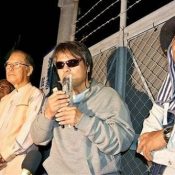
March 19, 2019 Ryukyu Shimpo online edition
In April 2016 the Akutagawa Prize-winning author Shun Medoruma was captured by the United States military during his participation in protest activities against construction of the new base in Henoko, Nago City.
Medoruma was subjected to violations of his human rights and of the Constitution, including being detained for eight hours by the U.S. military and arrested by the Nakagusuku Coast Guard.
On the morning of March 19 in the damages lawsuit Medoruma brought against the Japanese government, the Naha District Court (presided over by Judge Kaoru Hirayama) ruled that the Nakagusuku Coast Guard did not have reasonable grounds for Medoruma’s delayed transfer from the U.S. military into Japanese custody, and that his arrest was illegal. Medoruma won his case.
(English translation by T&CT and Erin Jones)
Go to Japanese
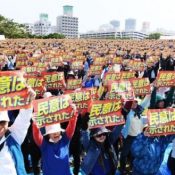
March 17, 2019 Ryukyu Shimpo
On March 16, the All Okinawa Coalition to Prevent Construction of a New Base in Henoko held a rally called “No soil dumping! 3/16 Okinawan people’s rally to protect the dugong and coral and demand a stop to the Henoko new base construction” at the Naha Shintoshin Park in Naha, Okinawa.
According to organizer estimates, 10,000 people showed up to call on the government to honor the referendum result showing opposition to the reclamation of land in Henoko, Nago.
A resolution was adopted at the rally calling for an immediate halt to the base construction, as the Ministry of Defense’s Okinawa Defense Bureau plans to start dumping soil into a new reclamation zone as early as March 25 for the construction of a new base as part of the relocation of U.S. Marine Corps Air Station Futenma in Ginowan. Governor Denny Tamaki sent the following message to the rally participants: “I will honor the will of the people demonstrated in the referendum above all else and continue to fight unwaveringly until the Japanese and U.S. governments abandon the construction of a new base in Henoko.”
The resolution referred to the fact that more than 70% of voters in the February 24 referendum expressed opposition to the Henoko land reclamation and demanded “a stop to the reclamation work and immediate abandonment of the new base construction in Henoko in deference to the overwhelming will of the Okinawan people demonstrated in the referendum.”
It called on the Japanese and U.S. governments to abandon the new base construction in Henoko, remove the soil for land reclamation, reverse the Osprey deployment, and close and remove U.S. Marine Corps Air Station Futenma.
On March 19, All Okinawa Coalition co-representatives Susumu Inamine and Suzuyo Takazato and Council Against the Helipad co-representative Hiroshi Ashitomi will bring the resolution to Tokyo and petition the Japanese government together with Okinawa’s representatives who belong to the opposition party in the National Diet.
The Okinawa Defense Bureau, which began dumping soil off the coast of Henoko in December of last year, continued the construction work even after the referendum, and has notified the Okinawa prefectural government that it plans to start dumping soil into a new reclamation zone on March 25. At the rally, all participants held up message boards reading “Stop dumping soil” and “The people have spoken,” and raised their voices in protest.
At the rally, Vice Governor Kiichiro Jahana read a message from Governor Tamaki, who was in Miyakojima to attend a ceremony for the completion of an airport terminal on the island of Shimojijima.
Governor Tamaki’s message emphasized the significance of the referendum, stating, “The directly demonstrated will of the people is of utmost importance in a democratic nation such as our own, and must be honored.”
It criticized the government’s stance and continued insistence by Prime Minister Shinzo Abe and Defense Minister Takeshi Iwaya on proceeding with the reclamation work in spite of the referendum result.
The governor’s message also stated, “The ground at the planned construction site is weak over a wide and deep area. We cannot let the dangers posed by Futenma go unaddressed as a result of the government’s insistence on the Henoko relocation.”
The governor pledged to call on the national government to stop the reclamation work and endeavor to find a resolution through dialogue with the prefectural government.
(English translation by T&CT and Sandi Aritza)
Go to Japanese
March 18, 2019 Ryukyu Shimpo
By Yukito Toyama
U.S. military pilots who fly under the influence are not subject to Japanese law. On March 8, the Lower House Foreign Affairs Committee discussed the U.S. military’s exemption from most of Japan’s aviation laws.
Japan’s aviation law provides special provisions that exempt U.S. forces based on the Japan-U.S. Status-of-Forces Agreement, or SOFA. Kazunori Inoue, policy chief of the Hope Party (Kibou no Tou) asked questions, and called for talks with the U.S. to make these laws applicable to its military.
A member of the foreign ministry took a passive tone and responded, “the U.S. military pays proper attention to public safety when flying.”
Aviation laws prohibits flying under the influence of alcohol or drugs; enforces the minimum safety altitude; and regulates unruly maneuvers, such as loops and aerobatics.
Owing to the special provisions, these restrictions, along with most of chapter six of the Civil Aeronautics Act, are not applicable to U.S. forces.
Although Japan’s self-defense force is also exempt from some restrictions, more rules apply to the SDF than the U.S. military, and exemptions only apply to SDF pilots mobilized during defense operations.
Inoue pointed out to the Lower House Foreign Affairs Committee, “A seemingly obvious rule against drinking and flying applies to the SDF and not to the U.S. military.
” He also commented on an incident in which a part fell from a U.S. military helicopter flying over Okinawa: “The U.S. military must be subject to Japanese aviation laws, to ensure the U.S. is sufficiently aware that unsafe flying is unacceptable.”
Foreign Minister Taro Kono responded, “The administration intends to work out the various issues surrounding SOFA in an effective and swift way,” and avoided discussing specifics.
(English translation by T&CT and Monica Shingaki)
Go to Japanese
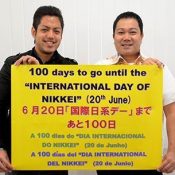
March 13, 2019 Ryukyu Shimpo
At Meio University in Nago City on March 12 Andres Higa, 43, a second generation Okinawan-Argentinian, and Andres Tadashi Isa, 28, a third generation Okinawan-Peruvian promoted the “International Day of Nikkei” 100 days in advance of the event.
The International Day of Nikkei (Japanese ancestry) will be held every year on June 20 to strengthen connections among people of Japanese descent and establish their identity as Nikkei.
On the day of the event, Higa and Isa plan to hold a cultural exchange event inviting Nikkei and related people, and give a presentation on the history of Japanese emigrants.
The venue and time will be made available soon. These two men are calling for many Nikkei and Japanese people to participate and interact with each other.
June 20, 1868 was the day that the first group of Japanese people arrived in Hawaii, and last year the Association of Nikkei and Japanese Abroad declared International Day of Nikkei.
Higa and Isa proposed the event and worked to establish it.
Higa said, “We are here due to the history of [Japanese] emigration. Many Japanese people do not know about the emigrants. We want you to know the emigration history for the International Day of Nikkei.”
The two men also worked on the establishment of October 30 as “World Uchinanchu Day.” Isa stressed that, “We want Japanese people and Nikkei people to cherish the International Day of Nikkei just as Uchinanchu do World Uchinanchu Day.
We want to create a relationship in which Japanese and Nikkei can help each other, like a family.”
(English translation by T&CT)
Go to Japanese
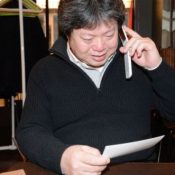
March 19, 2019 Ryukyu Shimpo
By Hiroe Nakagawa
“I want to say my thanks to the people of Okinawa who saved my life.
Not a day goes by where I forget what you did for me.” Masakazu Minami (50, Vietnamese name: John Tai Tuan Vin), who runs a Vietnamese restaurant in Tokyo, continues to carry these thoughts with him. Minami fled his home country of Vietnam in August of 1983 on a wooden ship, and was rescued off the coast of Ho Chi Minh City by the Shonan-maru, an Okinawan fishing training vessel from Okinawa Suisan (fishery) High School.
With help from the Ryukyu Shimpo, Minami was able to learn the name of the ship and the contact information of the captain of the ship at the time, Gensho Miyagi (75, formerly Gensho Shimoji).
On March 16, 36 years after being rescued, Minami spoke on the phone with Miyagi, giving his thanks with tears rolling down.
On August 4, 1983, the 14-year-old Minami boarded a small wooden boat and left Vietnam. With the support of his grandfather, he decided to flee abroad to escape the troubles in his home country.
In the middle of the night after four days at sea, he saw a small light out in the dark ocean. The next morning, he discovered that it came from a Japanese ship, and waving a torch and lifebuoy, he called out to be rescued.
Minami reflected, “I was saved. My life was preserved.”
The Shonan-maru had 69 students from the Okinawa Suisan High School aboard, having departed from Tomari Fishing Port in Naha in June. The ship discovered the wooden boat while making its way back home.
The maximum capacity of the Shonan-maru was 75 people, however Miyagi reckoned that they rescued around 105 people in total from the wooden ship.
The Shonan-maru changed course for Manilla in the Philippines, where they handed over the survivors to the Philippine government.
Minami then travelled from Manilla to a refugee center in Nagasaki, before being placed at the Motobu International Friendship Center in Motobu by the Japanese Red Cross’ Okinawa Branch, where he spent the next eight months.
After that, Minami went moved to Tokyo, where he decided to live permanently in his second home country of Japan.
In the nineties, he became a Japanese citizen, and he currently owns and operates the Vietnamese restaurant “Yellow Bamboo” in Uchisaiwai-cho, Chiyoda Ward.
Last summer, a teacher at a private high school in Okinawa visited Minami’s restaurant in Tokyo.
After hearing the story of his rescue 36 years ago, the teacher relayed the story to this paper. The paper inquired with the parties involved, and was able to learn the name of the ship as well as Miyagi’s contact information.
Minami said his thanks while tears rolled down his face. “If I had not been rescued I would not be here now.
I am sorry I have not been able to say thank you until now.” He then promised, “I want to tell you about my life until now.
I will come to Okinawa.”
Miyagi said happily, “I think we did the right thing. I am happy to hear that he had a successful life.”
(English translation by T&CT and Sam Grieb)
Go to Japanese
March 14, Ryukyu Shimpo
Shocking data has once again indicated just how dangerous U.S. Air Force Kedena Air Base’s aircraft noise is, along with just how inhumane the current base operations are.
It is estimated that 17,454 residents from the Kadena Air Base area suffer from severe sleep deprivation. In addition, it is estimated that annually, 51 people develop ischemic heart disease and 10 people die as a result of the noise pollution.
Hakkaido University Professor Toshihito Matsui calculated and published the abovementioned figures, which were based on the guidelines on noise pollution that were published last October by the World Health Organization (WHO) Europe Region.
Assuming that the effects of the ground-level noise pollution within the flying grounds would be large, he included engine adjustments and taxiing into the estimate.
There had not been a solid measurement method for the effects of the ground-level noise pollution within the flying grounds.
He created an even more precise noise pollution contour, or distribution map, that took how the noise pollution branches out, topography, and buildings.
He then calculated the number of people affected and risks by noise pollution level.
The criteria for the effects of noise pollution on health by the WHO or WHO Europe Region have been published six times starting with the first criteria established in 1980.
In 1999, guidelines indicating the threshold values in which health issues arise were announced.
It pointed out that chances of cardiovascular diseases increase in areas that suffer from severe noise pollution.
In last year’s guidelines, it mentions heart diseases, hypertension, and diabetes.
These have also been shown in research findings from areas other than Europe and these standards are universal.
The 1999 guidelines were published the year following the appealed court ruling of the first Kedena Air Base noise lawsuit.
The focal point during the said court ruling had been impact on health, but the Fukuoka High Court Naha Branch would not recognize it as they were “unable to draw a conclusion.”
While further emphasis was placed on proving the impact on health, the case was turned down during the verdict of the first hearing in 2005 since “a causal relationship between noise pollution and health problems could not be recognized.”
Similarly in the 2009 appealed court decision, the Supreme Court rejected the final appeal. The government and judiciary have ignored the WHO guidelines.
In the third lawsuit, Professor Matsui testified as an expert witness in line with the WHO guidelines and emphasized the impact on health.
The first ruling in 2017 finally but partially recognized the impact on health. In addition to nuisance and sleep deprivation, it recognized the noise “leads to increased risk of adverse effects on health, such as hypertension.”
But this still remains far from the WHO standards.
Up until now, the judiciary has not permitted a ban on U.S. aircraft flights at night and in the early morning.
This is due to a “third party act theory” where the “government cannot restrict the operations of U.S. military aircrafts.” In addition, they also claimed “the security treaty which is highly political in nature does not fall under judicial rule” in the name of “political question.”
The appealed court decision for the third lawsuit is to be delivered this coming September.
Now that the impact on health that can danger one’s life has been made clear more than ever, we would hope the judiciary addresses and bans flights. We would like to strongly call into question these “third party acts” that appear to take precedence over the lives of the people.
(English translation by T&CT and Chelsea Ashimine)
Go to Japanese

March 15, 2019 Ryukyu Shimpo
Three Okinawan members of the All Japan National Team, Ryo Kiyuna (Konan High School, Okinawa International University, Ryueiryu Ryuhokai), Arata Kinjo (Mirai Engineering High School, Okinawa International University, Ryueiryu Ryuhokai), and Takuya Uemura (Konan High School, Okinawa International University, Ryueiryu Ryuhokai), joined with two female competitors, Kiyou Shimizu and Emiri Iwamoto, to train at the Okinawa Prefectural Budokan in Naha.
The training ran through March 15. This is the first time Okinawa has hosted an Olympic training session that brought together the top karate-ka in the world in Kiyuna and Shimizu.
The athletes were trained by Ryueiryu Ryuhokai president and seven-straight world championship winner Tsuguo Sakumoto, who coached them on the interconnectivity and spirit of Ryueiryu technique, instilling into the athletes bodies the forms and movements.
The Olympic-bound Kiyuna said, “With each tournament I win, the more and more I want to race towards the Olympics,” and Shimizu commented, “Looking towards 2020, I want to perform a martial arts demonstration that leaves nothing to regret.”
(English translation by T&CT and Sam Grieb)
Go to Japanese
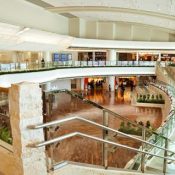
March 14, 2019 Ryukyu Shimpo
On March 13 the Naha Airport Building Co. Ltd. (NABCO), which manages the terminal buildings of Naha Airport, held a ceremony celebrating the completion of the new terminal building linking the international and domestic terminal buildings.
The new building will open for use on March 18, and is organized into three stories similar to the ways in which the international and domestic terminals are organized.
Arrivals are on the first floor, departures are on the second floor, and check-in is on the third floor.
This building linking the terminals is expected to increase airport convenience for passengers, such as by increasing ease in making connecting flights.
Use of the second runway at Naha Airport is expected to start in March 2020, which, along with the new linking terminal, is likely to accommodate 158,000 civilian aircraft takeoffs and landings per year.
Currently, there are 20 check-in counter booths in the international terminal building. These will be moved to the third floor of the linking building and will be increased three-fold to 60 booths.
Other installations, such as the check-in counters in the LCC terminal, will also be moved. A system that automatically inspects checked baggage will be introduced, too, and it is anticipated that this system will facilitate the boarding process.
In total there will be 36 vendors that set up shop in the new building linking the terminals, in view of inbound foreign visitors and domestic customers.
There will be restaurants to satisfy a variety of needs.
On the second floor there will be a shop called Yuinichi Street, directed at attracting inbound visitors and lined with hand-picked commodities from Japan and Okinawa.
Officials and persons involved in the tourist industry attended the ceremony.
NABCO President Satoshi Kaneshima delivered a greeting at the ceremony.
He said, “We work to provide peace of mind and safety first and foremost, as well as convenience and comfort.”
(English translation by T&CT and Erin Jones)
Go to Japanese
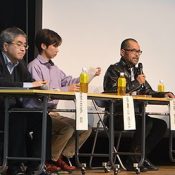
March 11, 2019 Ryukyu Shimpo
ACSILs, The Association of Comprehensive Studies for Independence of the Lew Chewans, held its 21st open symposium on March 10 at the Ginowan City Community Hall, titled: “Investigating the 140 Years Since Yamato State’s Annexation of the Ryukyu Kingdom (Known as the Ryukyu Disposition).”
Speakers included Kanagawa University’s Associate Professor Atsushi Shiitada; music teacher and YouTuber, Yuzo Takayama; and Ryukoku University professor, Yasukatsu Matsushima.
Speakers looked back on Okinawan history, from the dissolution of the Ryukyu Kingdom in 1879 by Japan and its military force (referred to as the Ryukyu Disposition), to the Battle of Okinawa, leading up to the current construction of a new base in Henoko.
They also discussed Japanese colonialism. Roughly 230 people attended.
Shiitada said of the annexation, “Okinawa was the first colony Japan acquired and to this day, it is still a colony.
Japan is one of the few democratic countries that has not let go of its colony.
” He asserted the prefecture should “propose the third U.S.-North Korea summit be held in Okinawa. It will be a step toward thinking about Okinawa’s path forward.”
Takayama explained his connection with his ancestor, the Ryukyuan king, Shō Shin. He stressed that, “in order to revive our unique history and culture, and to escape colonialism, Ryukyu must build self-reliance and independence.
To establish the Uchinanchu (Okinawan) identity, it’s crucial for each and every one of us to express it,” He intends to do the same, while “hopefully grounding the message in easy-to-understand and clear evidence, while making it entertaining as well.”
Matsushima criticized the central government for “never admitting it annexed Ryukyu by force, nor has is apologized or paid reparations.”
The Ministry of Foreign Affairs of Japan is in possession of an amity treaty the Ryukyu Kingdom signed with three other countries, including the U.S. He commented, “there should be legal action to have the treaty returned. The Ryukyu Kingdom no longer exists, but the descendants of the Ryukyuans have a right to demand its restoration.”
English translation by T&CT and Monica Shingaki
Go to Japanese









 Webcam(Kokusai Street)
Webcam(Kokusai Street)


